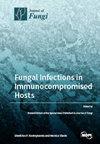囊性纤维化跨膜传导调节器(CFTR)调节剂时代的过敏性支气管肺曲霉病(ABPA)
IF 4.2
2区 生物学
Q2 MICROBIOLOGY
引用次数: 0
摘要
过敏性支气管肺曲霉菌病(ABPA)是由烟曲霉菌(Af)引起的超敏性疾病,在囊性纤维化(CF)或哮喘患者中很常见。在 ABPA 中,Af 蛋白酶驱动 T 辅助细胞-2(Th2)介导的过敏性免疫反应,导致炎症,造成永久性肺损伤。皮质类固醇和抗真菌药物是治疗 ABPA 的主要药物。然而,长期使用这些药物会产生负面后遗症。囊性纤维化跨膜传导调节剂(CFTR)调节剂疗法的疗效彻底改变了对 CF 患者(pwCF)的治疗。高效的 elexacaftor/tezacaftor/ivacaftor(ETI)通过药理学改善了 CFTR 功能,使肺功能和 pwCF 的其他临床疗效得到了前所未有的改善。随着我们对 CFTR 功能作用的认识不断加深,患者预后改善背后的机制仍是一个研究课题。随着 ETI疗法在CF治疗中逐渐受到重视,了解其对ABPA的潜在影响,尤其是对过敏性免疫反应途径和Af感染的影响,对于优化患者预后变得越来越重要。本文献综述旨在研究这些发现的程度,并扩展我们对已发表研究的理解,这些研究侧重于 CF ABPA 治疗方法与不断发展的 CFTR 调节剂的快速影响之间的交叉点。虽然我们的文献检索结果显示,专门关注 CFTR 调节剂疗法对 CF-ABPA 的作用的报告有限,但流行病学和回顾性研究的结果表明,CFTR 调节剂疗法有可能通过解决 CF-ABPA 的潜在病理生理学问题,特别是通过减少炎症反应和 Af 定殖,对肺部结果产生积极影响。因此,本综述强调了 CFTR 调节剂疗法在降低 CF-ABPA 总患病率和发病率方面的前景。本文章由计算机程序翻译,如有差异,请以英文原文为准。
Allergic Bronchopulmonary Aspergillosis (ABPA) in the Era of Cystic Fibrosis Transmembrane Conductance Regulator (CFTR) Modulators
Allergic bronchopulmonary aspergillosis (ABPA) is a hypersensitivity disease caused by Aspergillus fumigatus (Af), prevalent in persons with cystic fibrosis (CF) or asthma. In ABPA, Af proteases drive a T-helper cell-2 (Th2)-mediated allergic immune response leading to inflammation that contributes to permanent lung damage. Corticosteroids and antifungals are the mainstays of therapies for ABPA. However, their long-term use has negative sequelae. The treatment of patients with CF (pwCF) has been revolutionized by the efficacy of cystic fibrosis transmembrane conductance regulator (CFTR) modulator therapy. Pharmacological improvement in CFTR function with highly effective elexacaftor/tezacaftor/ivacaftor (ETI) provides unprecedented improvements in lung function and other clinical outcomes of pwCF. The mechanism behind the improvement in patient outcomes is a continued topic of investigation as our understanding of the role of CFTR function evolves. As ETI therapy gains traction in CF management, understanding its potential impact on ABPA, especially on the allergic immune response pathways and Af infection becomes increasingly crucial for optimizing patient outcomes. This literature review aims to examine the extent of these findings and expand our understanding of the already published research focusing on the intersection between ABPA therapeutic approaches in CF and the rapid impact of the evolving CFTR modulator landscape. While our literature search yielded limited reports specifically focusing on the role of CFTR modulator therapy on CF-ABPA, findings from epidemiologic and retrospective studies suggest the potential for CFTR modulator therapies to positively influence pulmonary outcomes by addressing the underlying pathophysiology of CF-ABPA, especially by decreasing inflammatory response and Af colonization. Thus, this review highlights the promising scope of CFTR modulator therapy in decreasing the overall prevalence and incidence of CF-ABPA.
求助全文
通过发布文献求助,成功后即可免费获取论文全文。
去求助
来源期刊

Journal of Fungi
Medicine-Microbiology (medical)
CiteScore
6.70
自引率
14.90%
发文量
1151
审稿时长
11 weeks
期刊介绍:
Journal of Fungi (ISSN 2309-608X) is an international, peer-reviewed scientific open access journal that provides an advanced forum for studies related to pathogenic fungi, fungal biology, and all other aspects of fungal research. The journal publishes reviews, regular research papers, and communications in quarterly issues. Our aim is to encourage scientists to publish their experimental and theoretical results in as much detail as possible. Therefore, there is no restriction on paper length. Full experimental details must be provided so that the results can be reproduced.
 求助内容:
求助内容: 应助结果提醒方式:
应助结果提醒方式:


